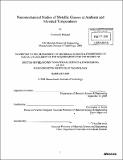Nanomechanical studies of metallic glasses at ambient and elevated temperatures
Author(s)
Packard, Corinne E
DownloadFull printable version (41.49Mb)
Other Contributors
Massachusetts Institute of Technology. Dept. of Materials Science and Engineering.
Advisor
Christopher A. Schuh.
Terms of use
Metadata
Show full item recordAbstract
Bulk metallic glasses, though attractive for use in structural applications for their high strength and elastic limit, display several unacceptable features upon deformation, including quasi-brittle failure along shear bands, extremely limited tensile ductility, and propensity for fatigue under cyclic loading. Though researchers have studied metallic glasses for the last fifty years, several fundamental aspects of the mechanical deformation process in these materials have not been conclusively established. In this thesis, new instrumentation and techniques were developed to study the deformation mechanism of metallic glasses, enabling a focused, high-resolution method for probing nanomechanical behavior. A nanoindenter capable of sub-nanometer and sub-microNewton resolution was outfitted with a custom heating stage and installed in a controlled atmosphere chamber to allow for high fidelity testing in a non-oxidizing environment across a range of deformation regimes. Using this system, the process of shear band initiation near a stress concentration was investigated using a low load indentation technique, revealing that high stresses at a point directly beneath the contact are not sufficient to cause shear band release to the free surface, but instead the potential for material flow along a slip line to relieve stress must be considered. Additionally, the distribution of strengths associated with the yield event was identified and its origins were determined to be mainly structural by using a variety of specially designed loading functions to examine rate, stress, and dynamic loading dependencies. (cont.) Elevated temperature testing in the custom indentation system allowed in situ observation of the transition from discrete accommodation of strain in shear bands to homogeneous flow as well as characterization of the main features of viscous flow above the glass transition temperature. With the development of these new high-resolution testing methods, new avenues of experimental investigation have been opened, allowing insight into the fundamentals of plastic flow in metallic glasses across a spectrum of conditions.
Description
Thesis (Ph. D.)--Massachusetts Institute of Technology, Dept. of Materials Science and Engineering, 2009. Includes bibliographical references (p. 116-127).
Date issued
2009Department
Massachusetts Institute of Technology. Department of Materials Science and EngineeringPublisher
Massachusetts Institute of Technology
Keywords
Materials Science and Engineering.